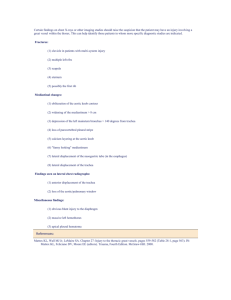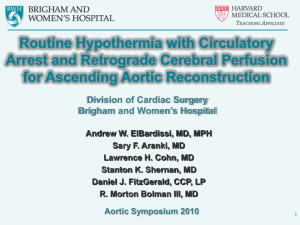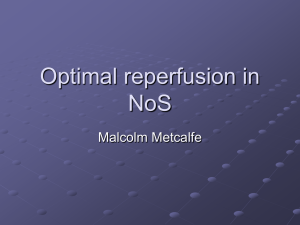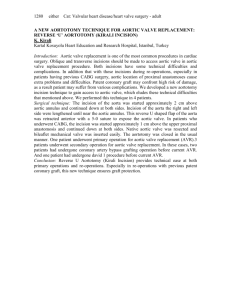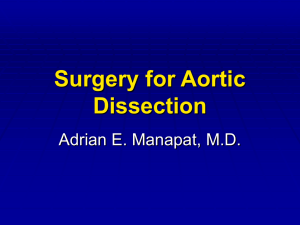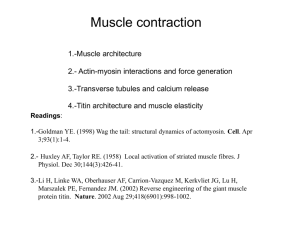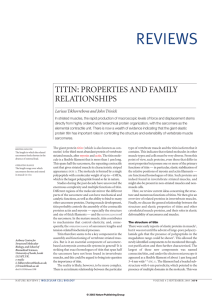Online supplement - European Heart Journal
advertisement
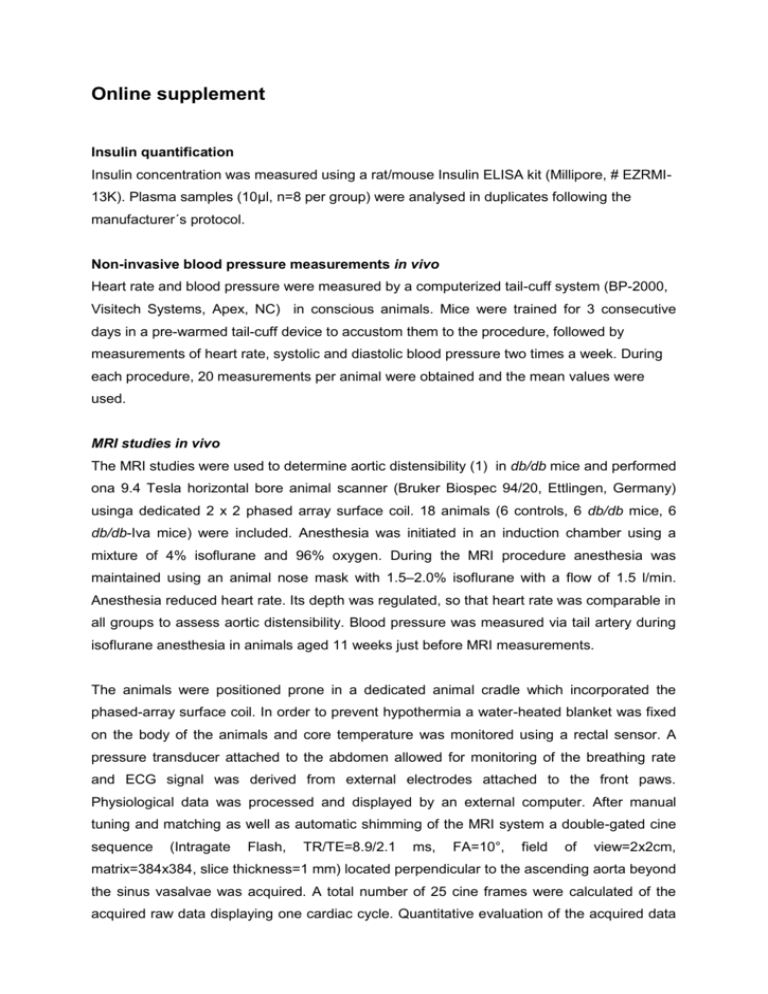
Online supplement Insulin quantification Insulin concentration was measured using a rat/mouse Insulin ELISA kit (Millipore, # EZRMI13K). Plasma samples (10μl, n=8 per group) were analysed in duplicates following the manufacturer´s protocol. Non-invasive blood pressure measurements in vivo Heart rate and blood pressure were measured by a computerized tail-cuff system (BP-2000, Visitech Systems, Apex, NC) in conscious animals. Mice were trained for 3 consecutive days in a pre-warmed tail-cuff device to accustom them to the procedure, followed by measurements of heart rate, systolic and diastolic blood pressure two times a week. During each procedure, 20 measurements per animal were obtained and the mean values were used. MRI studies in vivo The MRI studies were used to determine aortic distensibility (1) in db/db mice and performed ona 9.4 Tesla horizontal bore animal scanner (Bruker Biospec 94/20, Ettlingen, Germany) usinga dedicated 2 x 2 phased array surface coil. 18 animals (6 controls, 6 db/db mice, 6 db/db-Iva mice) were included. Anesthesia was initiated in an induction chamber using a mixture of 4% isoflurane and 96% oxygen. During the MRI procedure anesthesia was maintained using an animal nose mask with 1.5–2.0% isoflurane with a flow of 1.5 l/min. Anesthesia reduced heart rate. Its depth was regulated, so that heart rate was comparable in all groups to assess aortic distensibility. Blood pressure was measured via tail artery during isoflurane anesthesia in animals aged 11 weeks just before MRI measurements. The animals were positioned prone in a dedicated animal cradle which incorporated the phased-array surface coil. In order to prevent hypothermia a water-heated blanket was fixed on the body of the animals and core temperature was monitored using a rectal sensor. A pressure transducer attached to the abdomen allowed for monitoring of the breathing rate and ECG signal was derived from external electrodes attached to the front paws. Physiological data was processed and displayed by an external computer. After manual tuning and matching as well as automatic shimming of the MRI system a double-gated cine sequence (Intragate Flash, TR/TE=8.9/2.1 ms, FA=10°, field of view=2x2cm, matrix=384x384, slice thickness=1 mm) located perpendicular to the ascending aorta beyond the sinus vasalvae was acquired. A total number of 25 cine frames were calculated of the acquired raw data displaying one cardiac cycle. Quantitative evaluation of the acquired data included the assessment of the vessel lumen at end-systole and end-diastole. Aortic distensibility was calculated according to Hundley et al. (20): Aortic distensibility = pulse pressure x diastolic aortic area / (systolic aortic area – diastolic aortic area). Working heart preparation The aorta was cannulated with an 18-G metal cannula for a Langendorff retrograde perfusion (60 mmHg perfusion pressure) with Krebs-Henseleit buffer (KHB) in a working heart apparatus (IH-SR Perfusion system type 844/1 Hugo Sachs Elektronik, MarchHugstetten, Germany) (2). After establishing coronary perfusion in the Langendorff mode, “working heart” preparation was continued by cannulating left atrium (LA) through the pulmonary vein with a 16-G steel cannula. This cannula was connected to a preload column, which was water- jacketed and heated to 38°C, resulting in a myocardial temperature of 37°C when the heart was operating in the working mode (preload 10mmHg, afterload 60mmHg). Two platinum pacing electrodes embedded in polyester resin were attached to the right atrium to pace the hearts at about 400bpm (2). LV systolic and diastolic function was recorded via a high fidelity pressure- conductance catheter (Millar 1.4 F SPR-835, Millar, Houston, Texas) inserted into the LV cavity through a small puncture in the apex made with a 22 1/4 gauge needle. The end-systolic pressure volume relationship (ESPVR) and its slope Ees (end-systolic ventricular elastance) were assessed by a sudden increase in afterload pressure from 60 to 100mmHg while preload was kept constant at 10mmHg and a heart rate of 400bpm. Cardiac inflow and aortic flow were recorded continuously by inline ultrasonic transit time probes and these measurements were used to calibrate volume measurement of the conductance catheter signal gain. Parallel conductance (conductance signal offset) was determined by the saline dilution method by injecting a 5 l bolus of hypertonic (5%) saline into the left atrial cannula, causing a transient change in the conductivity of KHB in LV cavity. Immunohistochemistry of the aorta Oxidative stress Oxidative stress in the aorta was determined by assessing the vascular superoxide production in situ using dihydroethidium (DHE) fluorescence microscopy as described previously (3). Dihydroethidium fluorescence microscopy Dihydroethidium (DHE) is the chemically reduced form of the commonly used DNA dye ethidium bromide. DHE itself is blue fluorescent (absorption/emission: 355/420 nm) in cell cytoplasm while the oxidized form ethidium is red fluorescent (absorption/emission: 518/605 nm) upon DNA intercalation. Aortas were carefully excised and placed in chilled, modified Krebs-HEPES buffer. Connective tissue was removed and aortas were cut into 4-mm segments, which were embedded in Tissue Tek OCT embedding medium (Miles Laboratories), snap-frozen, and stored at -80°C. Samples were sectioned on a Leica cryostat (10 μm) and placed on glass slides. Then, Krebs-HEPES buffer containing 2 μmol/L DHE was topically applied to each tissue section and sections were incubated in a dark humidified chamber at 37°C for 30 min. In situ production of superoxide was visualized by fluorescence microscopy. Images were acquired with identical acquisition parameters and were stored digitally (4). Collagen content To assess vascular collagen content, sirius red staining of aortic-sinus sections was performed. Aortic sections were incubated with the sirius red agent (picro-sirius red solution 0.1% containing sirius red 0.1%, picrin acid 1.2%) for 10 minutes after washing with descendent ethanol concentrations (100%, 90% and 70%) and subsequent incubation with xylol for two minutes. Aortic collagen content was quantified using fluorescence microscopy through polarized light (G-2A-fluorescence filter, excitationspectrum 510-560 nm, exposure time 83ms, 40-fold magnification). Aortic sections from each treatment group were processed in parallel, and images were acquired with identical acquisition parameters, especially a constant area of integration was recorded for each section. Collagen content was expressed as fraction (percentage) of the total cross-sectional area. NO staining Diaminofluoreszein diacetate (DAF DA) is a non-fluorescent agent that permeats cell membranes. Inside the cell DAF DA is hydrolized by esterases in cytosol relieving DAF. DAF is captured within the cell because in can not permeate cell membranes. It reacts with NO to a fluorescent triazol derivate showing green fluorescence at its excitation maximum of λ = 488 nm and its emission maximum of λ = 515nm (5). The signal of fluorescence correlates strongly with the amount of NO located intracellularly (5). Immunohistochemistry left ventricle Formalin-fixed specimens were embedded in paraffin. For pre-treatment slices with paraffinembedded 3 µm-thick sections were placed in Coplin jars with 0.05% citraconic anhydride solution, pH 7.4 for 1 hour at +98°C and then incubated overnight at 4°C with the first antibody, followed by the appropriate secondary antibody at 37°C for 1 hour. Serial sections were immunostained for capillaries and cardiomyocytes using goat-anti-podocalyxin antibody (1:20; R&D Systems, USA) and mouse-anti-α–sarcomeric actin (1:30; clone5c5, SigmaAldrich, Germany) respectively. FITC-, TRITC– (all Dianova, Germany) anti-goat IgG and anti-mouse IgM were used as secondary antibodies. Sections were counterstained with DAPI (Calbiochem, Germany), washed and mounted with fluorescent mounting medium (Vectashield, Vector Laboratories, Burlingame, CA) for fluorescence microscopic analysis. All sections were evaluated using a Nikon E600 epifluorescence microscope (Nikon, Germany) with appropriate filters. Tissue morphometry For morphometric analyses, left ventricular tissue sections (3 µm) double stained for podocalyxin and α-sarcomeric actin were examined. Cross-sectioned capillaries and cardiomyocytes were counted in15 randomly chosen fields at 1000x magnification by superimposing of the sampling greed. Density of capillaries and cardiomyocytes was calculated from the obtained values using the formula: cell density (mm2)=cell number in 15 fields/((0.00153664)*15), where 0.00153664 is the area of the sampling grid at 1000x magnification, 15 is the number of counted fields. At least 8 hearts from each mouse group were evaluated for these parameters Western blot analysis Mouse LV tissue was minced in liquid nitrogen and resuspended in 5 volumes of homogenization buffer (in mM): Na2EDTA 5.0, NaF 25.0, sucrose 300.0, PMSF 1.0, benzamidine 1.0 and KH2PO4 30.0 (pH 7.0) containing complete protease inhibitors (Roche, Germany) and phosphatase inhibitors (Roche, Germany). The homogenate was centrifuged at 16.000 g for 20 min. 50 μg of protein was separated on 8-12% SDS-PAGE and electrophoretically transferred to nitrocellulose membrane (0.2 μm pore size, Schleicher and Schuell, Dassel, Germany). Membranes were blocked in Tris-buffered saline (TBS) containing 5% nonfat dry milk for 120 min at room temperature and exposed to rabbit polyclonal anti-phospho-phospholamban Thr17 (sc-17024-R, Santa Cruz Biotechnology, CA, USA; dilution: 1:400), rabbit polyclonal anti-phospho-phospholamban Ser16 (#07-052, Upstate, Millipore: dilution: 1:400), mouse monoclonal anti-Phospholamban (#05-205, Millipore: dilution: 1:500), anti-goat polyclonal Serca2 (N-19, sc-8095, Santa Cruz, 1:1000), rabbit anti-Akt (#9272, Cell Signalling, 1:1000), rabbit anti-phospho Akt Ser 473 (#9271, Cell Signalling, 1:1000) and mouse monoclonal IgG GAPDH (6C5: sc-32233, Santa Cruz Biotechnology, 1:5000). Secondary antibodies goat anti-rabbit (Sigma-Aldrich, Deisenhofen, Germany; 1:2500), goat anti-mouse (170-6516 Bio-Rad, Germany; 1:2500) and rabbit antigoat (Bio Rad, Germany; #172-1034) were incubated for 60 min at room temperature. Proteins were visualized by enhanced chemiluminescence according to the manufacturer´s guidelines (Amersham Pharmacia Biotech, Freiburg, Germany). Autoradiographs were quantified by imaging densitometry and analysed by the „ImageQuant-TM“ b Software (Image Quant, Molecular Dynamics, Krefeld, Germany). Data are presented as intensity optical density (IOD). Reverse Transcription RNA was prepared from mouse LV-tissues using peqGold TriFast (PeqLab, Erlangen, Germany) extraction reagent per manufacture´s protocol. For cDNA preparation 2μg of RNA were digested with DNAse (Peqlab, Erlangen) than reverse transcripted using the HighCap cDNA RT Kit (Applied Biosystems, Darmstadt, Germany) according to the manufacture´s protocol. Real-Time PCR Real-Time PCR was conducted in a StepOne plus thermocycler (Applied Biosystems, Germany) using PowerSYBR Green PCR Mastermix (Applied Biosystems). Signals were normalized to corresponding glyceraldehyde-3-phosphate dehydrogenase (GAPDH) controls. No template controls were used to monitor for contaminating amplifications. The ΔCt was used for statistical analysis and 2−ΔΔCt for data presentation. Primer sequences used to amplify the transcripts were as follows: GAPDH forward: ccc tgc atc cac tgg tgc tgc, GAPDH reverse: cat tga gag caa tgc cag ccc; CTGF forward: agc agc tgg gag aac tgt gt; CTGF reverse: gct gct ttg gaa gga ctc ac; Titin isoform transcript variant N2BA forward: gag aca ttg ctc cgc ttt tc; Titin isoform transcript variant N2BA reverse: gat ctc caa aga ggc tgt gc; Titin isoform transcript variant N2B forward: aca gtg gga aag caa aga cat c; Titin isoform transcript variant N2B reverse: agg tgg ccc aga gct act tc; Gel Electrophoresis For titin protein analysis, SDS–agarose electrophoresis was performed as previously described (1). Six mice per group were analyzed. Briefly, muscle samples were solubilized in a urea and glycerol buffer and analyzed by vertical SDS–agarose electrophoresis. The 1% agarose gels were run at 15 mA per gel for 3 h and 20 min. The gels were stained with Coomassie brilliant blue (CBB), and subsequently scanned and analyzed using One-D scan EX (Scanalytics Inc., Rockville, MD, USA) software. The integrated optical density of titin (N2B and N2BA isoforms) and MHC was determined as a function of the volume of solubilized protein sample that was loaded (a range of volumes was loaded on each gel). The slope of the linear range of the relationship between integrated optical density and loaded volume was obtained for each protein. Literature 1.) Hundley WG, Kitzman DW, Morgan TM Hamilton CA, Darty SN, Stewart KP, Herrington DM, Link KM, Little WC. Cardiac cycle-dependent changes in aortic area and distensibility are reduced in older patients with isolated diastolic heart failure and correlate with exercise intolerance. J Am Coll Cardiol 2001; 38:796–802. 2.) Reil JC, Hohl M, Oberhofer M, Kazakov A, Kaestner L, Mueller P, Adam O, Maack C, Lipp P, Mewis C, Allessie M, Laufs U, Böhm M, Neuberger HR. Cardiac Rac1 overexpression in mice creates a substrate for atrial arrhythmias characterized by structural remodelling. Cardiovas Res 2010; 87: 485-493. 3.) Wassmann S, Stumpf M, Strehlow K, Schmid A, Schieffer B, Böhm M and Nickenig G. Interleukin-6 induces oxidative stress and endothelial dysfunction by overexpression of angiotensin II type 1 receptor. Circulation research 2004; 94: 534-41. 4) Laufs U, Wassmann S, Czech T, Munzel T, Eisenhauer M, Böhm M and Nickenig G. Physical inactivity increases oxidative stress, endothelial dysfunction , and atherosclerosis . Arterosclerosis, thrombosis vand vascular biology. 2005; 25: 809-814. 5.) Kojima H, Nakatsubo N, Kikuchi K, Kawahara S, Kirino Y, Nagoshi H, Hirata Y, Nagano T. Detection and imaging of nitric oxide with diaminofluoresceins. Anal Chem 1998; 70: 2446-2453. novel fluorescent indicators: 1.) Lahmers S, Wu Y, Call DR, Labeit S, Granzier H. Developmental control of titin isoform expression and passive stiffness in fetal and neonatal myocardium. Circ Res 2004; 94: 50513.


